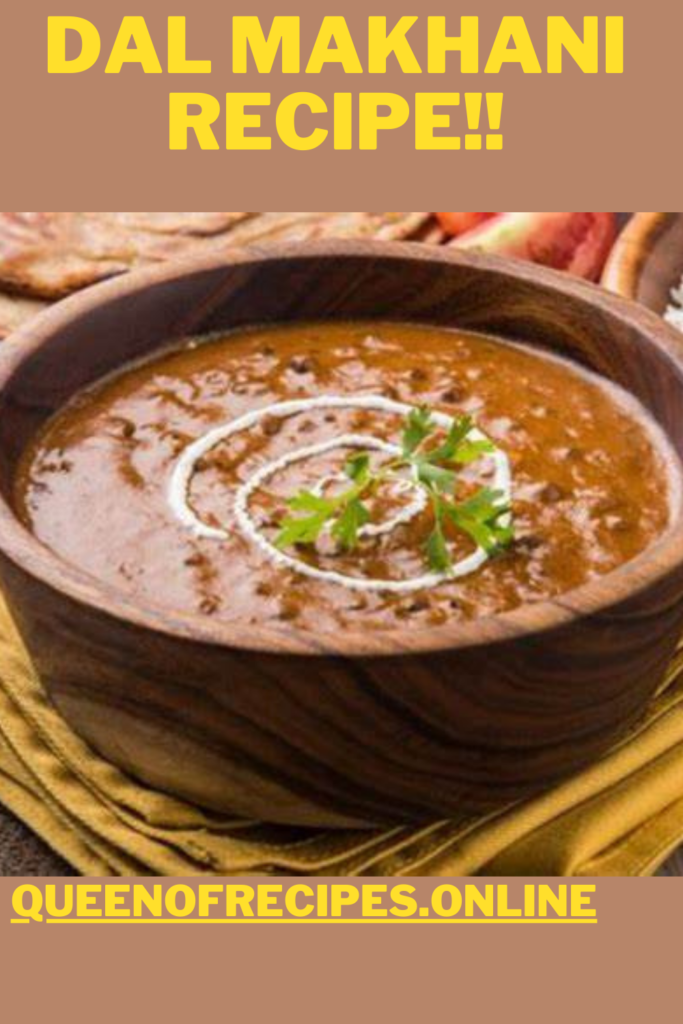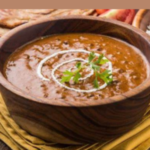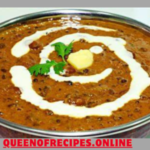Table of Contents
About Dal Makhani.
Dal Makhani is a classic North Indian dish that has gained popularity not only in India but also worldwide. It is a rich and creamy lentil preparation made primarily from black lentils (urad dal) and kidney beans (rajma). The name “Dal Makhani” translates to “buttery lentils,” and it accurately describes the dish. The lentils and kidney beans are simmered in a luscious tomato-based gravy, enriched with butter and cream, which gives the dish its creamy and indulgent texture. Dal Makhani is known for its delightful combination of flavors and is often served with naan, roti, or rice. It is a staple in Punjabi cuisine and is enjoyed as a hearty and satisfying meal.
Making Dal Makhani at home is a delightful process that yields a rich and creamy lentil dish. Here’s a basic recipe for you to prepare this classic North Indian dish:
Ingredients:
For the Dal:
- 1 cup whole black lentils (urad dal)
- 1/4 cup kidney beans (rajma)
- 4 cups water for cooking
- 1/2 teaspoon salt
For the Gravy:
- 3 tablespoons butter
- 1 tablespoon vegetable oil
- 1 large onion, finely chopped
- 1 tablespoon ginger-garlic paste
- 2 large tomatoes, pureed
- 1 teaspoon cumin seeds
- 1/2 teaspoon red chili powder (adjust to taste)
- 1/2 teaspoon turmeric powder
- 1 teaspoon garam masala
- 1 teaspoon ground coriander
- 1 teaspoon ground cumin
- 1/2 cup heavy cream
- Salt, to taste
For Garnish:
- Fresh coriander leaves, chopped
- Butter (optional)
Instructions:
1. Preparing the Lentils:
- Rinse the black lentils (urad dal) and kidney beans (rajma) in cold water. Soak them together in water for at least 4-6 hours or overnight.
- After soaking, drain the water and rinse the lentils and beans again.
- In a pressure cooker, combine the lentils, kidney beans, 4 cups of water, and 1/2 teaspoon of salt. Pressure cook them for about 15-20 whistles or until they are soft and well-cooked. You can also cook them in a regular pot, but it will take longer (about 1.5 to 2 hours).
2. Preparing the Gravy:
- Heat a combination of butter and vegetable oil in a pan or skillet over medium heat.
- Add cumin seeds and let them sizzle for a few seconds.
- Add the finely chopped onion and sauté until it becomes golden brown.
- Add ginger-garlic paste and sauté for a couple of minutes until the raw aroma disappears.
- Add the tomato puree and cook for about 10-15 minutes until the oil begins to separate from the tomato mixture.
- Stir in red chili powder, turmeric, garam masala, ground coriander, and ground cumin. Cook for a few minutes to roast the spices and blend the flavors.
3. Combining the Dal and Gravy:
- Add the cooked lentils and kidney beans to the tomato gravy. Mix well.
- Simmer the mixture on low heat for 20-30 minutes, stirring occasionally. This helps the flavors meld and the dal thicken.
- Stir in heavy cream and salt to taste. Continue cooking for an additional 10 minutes.
- If the dal is too thick, you can add a bit of water to reach your desired consistency.
4. Garnish and Serve:
- Garnish the Dal Makhani with chopped fresh coriander leaves and a dollop of butter (optional).
- Serve the Dal Makhani hot with naan, roti, or steamed rice.
Enjoy your homemade Dal Makhani, a creamy and aromatic delight that’s sure to please your taste buds.


Nutritional Value.
The nutritional value of Dal Makhani can vary based on the specific ingredients and cooking methods used, but here’s a general overview of its nutritional composition per serving (approximately 1 cup or 240 grams):
- Calories: 300-350 calories
- Protein: 10-15 grams
- Carbohydrates: 30-35 grams
- Dietary Fiber: 6-8 grams
- Sugars: 2-3 grams
- Fat: 15-20 grams
- Saturated Fat: 7-10 grams
- Cholesterol: 30-40 milligrams
- Sodium: 600-800 milligrams
- Potassium: 300-400 milligrams
- Vitamins: Dal Makhani can provide essential vitamins, including vitamin A, vitamin C, vitamin K, and various B vitamins.
- Minerals: It contains minerals like iron, magnesium, and calcium.
Please note that these values are approximate and can vary based on factors such as the portion size, the specific recipe, the amount of butter or cream used, and variations in ingredient brands. Dal Makhani is a rich and flavorful dish due to the presence of butter and cream, and it’s best enjoyed in moderation as part of a balanced diet.
Health Benefits.
Dal Makhani, while being a delicious and indulgent dish, does offer some potential health benefits due to its ingredients. Here are a few health aspects to consider:
- Good Source of Protein: Dal Makhani is rich in lentils (urad dal) and kidney beans (rajma), which are excellent sources of plant-based protein. Protein is essential for muscle development and overall health.
- High in Fiber: Lentils and beans are also high in dietary fiber, which can aid digestion, help regulate blood sugar levels, and support heart health.
- Rich in Iron: Lentils, especially black lentils, are a good source of iron. Iron is crucial for red blood cell production and preventing anemia.
- B Vitamins: The dish contains various B vitamins, including folate, which is essential for several bodily functions, including DNA synthesis.
- Antioxidant Content: Some of the spices used in Dal Makhani, such as turmeric and coriander, have antioxidant properties. Antioxidants help protect the body from damage caused by free radicals.
- Probiotics: The fermentation process of lentils can promote the growth of beneficial gut bacteria, potentially improving digestive health.
- Energy Source: The dish is calorie-dense, which can be beneficial for individuals needing an energy boost, such as athletes or those with active lifestyles.
It’s important to note that the health benefits of Dal Makhani can be outweighed by its high calorie, fat, and cholesterol content, primarily due to the use of butter and cream. Therefore, moderation is key, especially if you’re conscious of your calorie intake or have dietary restrictions. You can also consider preparing a lighter version of Dal Makhani by using healthier fats and reducing the quantity of cream and butter to make it a bit more health-conscious while still retaining its delicious flavors.
Tips and Tricks.
Making Dal Makhani can be a rewarding experience, but it requires attention to detail. Here are some tips and tricks to help you prepare a delicious batch of Dal Makhani:
- Soak the Lentils and Beans: Soak both the black lentils (urad dal) and kidney beans (rajma) for at least 4-6 hours or overnight. This reduces the cooking time and ensures they cook evenly.
- Use a Pressure Cooker: Pressure cooking the lentils and beans is the most efficient way to achieve a creamy texture. Cook them until they are soft and fully cooked.
- Lentil Mashing: After pressure cooking, mash a portion of the lentils and beans with a ladle to create a creamy base. This helps thicken the dish.
- Cream and Butter: Be generous with butter and cream if you want to achieve the rich and creamy texture characteristic of Dal Makhani. However, you can adjust the quantities to suit your taste and dietary preferences.
- Flavor Development: Allow the tomato gravy to cook until the oil begins to separate. This step is crucial for the flavor development of the dish.
- Spice Level: Adjust the level of red chili powder to your preferred spice level. Remember that some creaminess can counteract the heat.
- Fresh Ingredients: Whenever possible, use fresh ingredients, including tomatoes, ginger, and garlic. Fresh ingredients enhance the overall flavor of the dish.
- Resting Period: Let the prepared Dal Makhani rest for a while after cooking. This allows the flavors to meld, making it even more delicious when reheated.
- Garnish: Don’t forget to garnish with fresh coriander leaves and an extra dollop of butter for an authentic touch.
- Accompaniments: Serve Dal Makhani with naan, roti, or steamed rice for a complete meal. You can also pair it with pickles, raita, or Indian bread like parathas.
- Leftovers: Dal Makhani often tastes better the next day as the flavors continue to meld. If you have leftovers, refrigerate them and reheat when ready to enjoy.
By following these tips and tricks, you can prepare a sumptuous and flavorful batch of Dal Makhani that’s sure to be a hit at your table.


Serving Suggestions.
Dal Makhani is a versatile and hearty dish that can be served with various accompaniments to create a satisfying and complete meal. Here are some serving suggestions for enjoying Dal Makhani:
- Steamed Rice: Serve Dal Makhani with plain steamed rice, such as basmati rice. The creamy lentils complement the rice beautifully.
- Indian Breads: Pair Dal Makhani with naan, roti, or parathas for a classic Indian bread and lentil combination.
- Jeera Rice: Jeera rice, or cumin rice, is another great option. The mild cumin flavor pairs well with the rich and creamy Dal Makhani.
- Biryani: Enjoy Dal Makhani alongside a fragrant biryani for a delightful fusion meal.
- Indian Pickles: Add some tangy Indian pickles, such as mango pickle or lemon pickle, as a side condiment to complement the flavors.
- Raita: A cooling cucumber or mint raita can balance the richness of Dal Makhani and provide a refreshing contrast.
- Salad: A simple garden salad with fresh vegetables and a light dressing can provide a healthy and crunchy side dish.
- Papad: Crispy papads (thin lentil wafers) or fried papadums make for a crunchy accompaniment.
- Chutneys: Serve with a selection of chutneys, like mint chutney or tamarind chutney, to add a burst of flavor.
- Onions and Green Chilies: Sliced onions and green chilies with a squeeze of lemon can be a traditional side to add some freshness and heat.
- Lassi or Buttermilk: A glass of lassi or buttermilk can be a refreshing beverage to enjoy with Dal Makhani.
- Ghee: A drizzle of ghee (clarified butter) on top of the Dal Makhani can enhance the flavor and richness.
Feel free to mix and match these serving suggestions based on your personal preferences. Dal Makhani is a versatile dish that pairs well with a variety of accompaniments, allowing you to customize your meal to your liking.
FAQs.
Can I make a healthier version of Dal Makhani?



Yes, you can certainly make a healthier version of Dal Makhani by making some ingredient substitutions and adjustments to reduce the calorie and fat content. Here are some tips for creating a healthier Dal Makhani:
Use Less Butter: Reduce the amount of butter used in the recipe. You can cut it in half or use a healthier cooking oil like olive oil, canola oil, or ghee for a more nutritious option.
Choose Low-Fat Cream: Instead of heavy cream, opt for low-fat or reduced-fat cream or yogurt. This will cut down on the saturated fat content while still providing creaminess.
Add More Tomatoes: Increase the quantity of tomatoes in the recipe to enhance the flavor and texture of the gravy. Tomatoes are rich in vitamins and antioxidants.
Minimize the Creaminess: If you prefer a lighter texture, reduce the amount of cream used. Alternatively, use plant-based cream alternatives like coconut cream or almond cream for a dairy-free option.
Use Spices Wisely: Adjust the amount of spices and salt to your taste. This allows you to control the overall flavor and sodium content.
Reduce Sugar: If you’re using sugar in your recipe, consider using less sugar or even natural sweeteners like honey or maple syrup for a healthier option.
Incorporate Whole Grains: Serve your Dal Makhani with brown rice or whole wheat roti or naan for added fiber and nutrients.
Include Vegetables: Add vegetables like spinach, kale, or bell peppers to increase the nutritional value of the dish and provide extra fiber and vitamins.
Opt for Whole Lentils: Instead of split black lentils, you can use whole black lentils for more fiber and a lower glycemic index.
Portion Control: Pay attention to portion sizes to avoid overindulging. Dal Makhani is calorie-dense, so moderating your portions can help maintain a balanced diet.
By making these adjustments, you can create a healthier version of Dal Makhani without sacrificing flavor. It’s a great way to enjoy this classic Indian dish while being mindful of your dietary preferences and health goals.
Is Dal Makhani gluten-free?



Dal Makhani is naturally gluten-free as it doesn’t contain any wheat or gluten-based ingredients in its traditional recipe. The primary ingredients in Dal Makhani are lentils, kidney beans, spices, butter, cream, and vegetables, all of which are gluten-free.
However, when preparing or consuming Dal Makhani, it’s essential to be cautious about cross-contamination. If you’re following a strict gluten-free diet due to celiac disease or gluten sensitivity, ensure that the lentils, spices, and other ingredients you use are not contaminated with gluten during storage or preparation. Always check the labels of any pre-packaged or processed products used in the recipe to confirm their gluten-free status.
How long can I store leftover Dal Makhani?



You can store leftover Dal Makhani in the refrigerator for 3-4 days. To maintain its freshness and flavor, follow these steps for storing and reheating:
Cool Down: Allow the leftover Dal Makhani to cool to room temperature before refrigerating. Placing hot food in the fridge can raise its internal temperature and affect other items in the refrigerator.
Airtight Container: Transfer the Dal Makhani to an airtight container to prevent air and odors from affecting the dish.
Label and Date: Consider labeling the container with the date of preparation to track freshness.
Refrigerate: Store the container in the refrigerator within two hours of cooking.
Reheating: When you’re ready to enjoy the leftover Dal Makhani, reheat it on the stovetop or in the microwave until it’s heated through. You may need to add a splash of water or cream to restore the desired consistency.
After the recommended storage period, it’s best to discard any remaining leftover Dal Makhani to ensure food safety and quality.
What is the difference between Dal Makhani and Dal Tadka?



Dal Makhani and Dal Tadka are two popular Indian lentil dishes, but they have distinct differences:
Ingredients:
Dal Makhani: It is made with whole black lentils (urad dal) and kidney beans (rajma) cooked in a rich and creamy tomato-based gravy, often with the addition of butter and cream.
Dal Tadka: It typically uses yellow or red lentils (such as toor or masoor dal) and is characterized by its spicier and more tempered flavor.
Texture and Flavor:
Dal Makhani: Known for its creamy, indulgent texture and mild, buttery flavor.
Dal Tadka: Has a lighter, soupy consistency and a more pronounced, spicier flavor due to the tempering of spices.
Preparation Style:
Dal Makhani: Cooked over a longer period to achieve a creamy and harmonious blend of flavors.
Dal Tadka: Prepared relatively quickly, often with a tempering of spices at the end for a burst of flavor.
In summary, while both dishes are lentil-based, Dal Makhani is rich, creamy, and made with black lentils and kidney beans, while Dal Tadka is spicier, lighter, and prepared with different types of lentils, typically with tempering spices.

